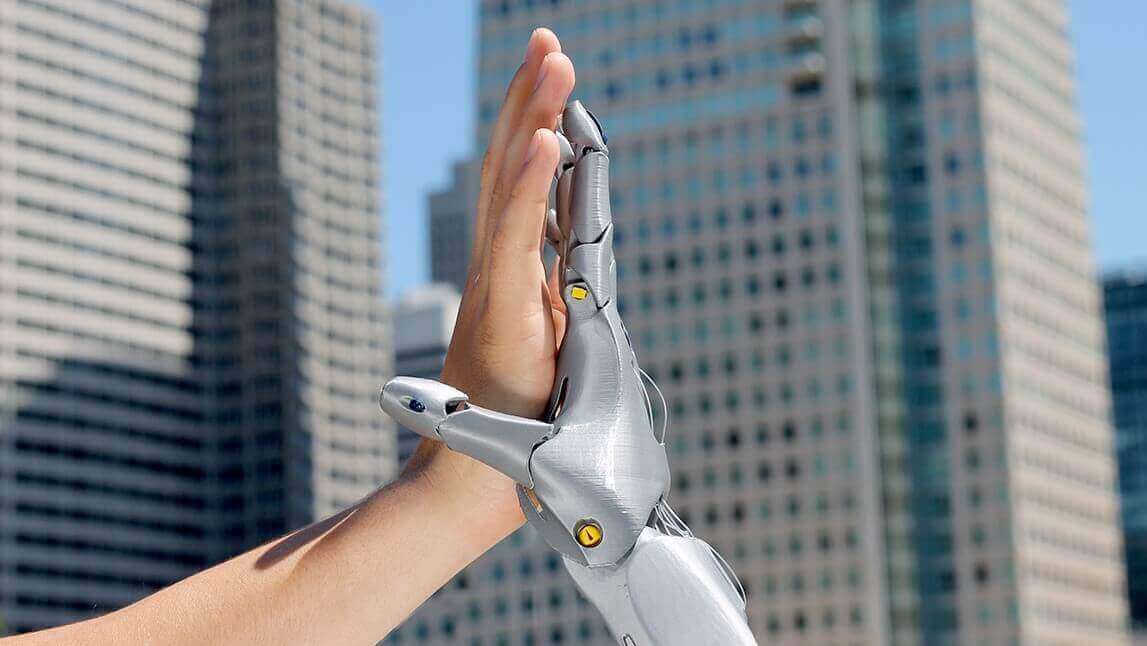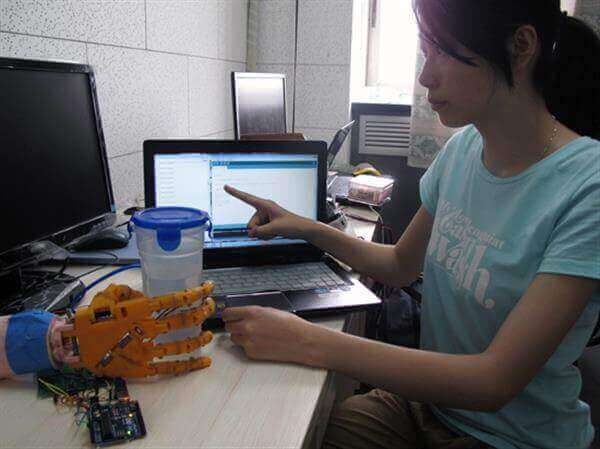In short: 3D printing makes sophisticated prosthetics much more affordable for everyone. Also, you can add electronics, which gives a 3D printed prosthesis a whole new dimension.
The oldest prostheses can be dated back as far as 2,000 BC. From Ancient Romans to Medieval knights, findings suggest that the well-situated were able to substitute missing limbs with decorative prostheses in order to not look crippled like the poor beggars. But it wasn’t until the 16th century that we have reports of iron hands, which were able to be opened and closed with the help of the working second hand. Goethe immortalized one of the owners (“Goetz of Berlichingen of the Iron Hand”) of such a simple hand prosthesis.
Another modern hero known for his full-body “prosthesis” recently handed a 3D printed prosthetic arm to a stunned seven-year-old. Watch Iron Man, pardon, Tony Stark, pardon, Robert Downey Jr. present a 3D printed bionic arm complete with movement and light effects:
https://www.youtube.com/watch?v=oEx5lmbCKtY
This video is also available in Blue Man group and Dolphin flavour.
3D Printed Prosthetics Will Be a Gamechanger
The next breakthrough in hand prostheses wasn’t until after WWI when amputees gained back a part of their abilities with the “Sauberbruch-Arm”. It could be moved with the help of the muscles on the upper arm, but was a very costly aid only few could afford.
In the last century, this hasn’t changed much. Prosthetics cost an arm and a leg instead of being able to substitute them. While technology advances with great strides, affordability is still a problem. A prosthesis with a simple motor-driven mechanism triggered by a myoelectric sensor typically costs a whopping $60,000 and more. That’s a sum one seldomly has put away for rainy days – especially not for an item that needs to be replaced every few years – or even months for children in their growth periods.
3D printed prosthetics aren’t that expensive. They have undergone development from simple artificial limbs to complex appendages with circuitry, mind control and “smart” functions.
3D Printed Prosthetic 1: The Lookalike
Cosmetic prostheses are built mainly out of silicone or rubberlike materials. They’re made to look like the real thing, but serve no further purpose than not to scare other people and calm the wearer a bit. Some of them get 3D printed to fit their wearer perfectly, but other than that, there are no unusual cases.
3D Printed Prosthetic 2: The Mechanic Limb

A simple but effective hand prosthetic, Robohand was started by Richard van As after a woodworking accident in May 2011 severing all his fingers on his right hand. Robohand has a mechanism that lets the wearer grasp and hold things with the prosthetic. After the first hand being made of aluminium, Robohand turned to 3D printing as a cheaper, quicker method.
With the design being published Open Source, anyone can 3D print a prosthetic hand for less than $50. As of November 2013 more than 200 hands have been made for individuals all over the world. Robohand also launched Robofinger and Roboarm to help even more cases, and the 3D printed Roboleg is in the works.
The e-NABLE community, coming from the same guys that invented the Robohand, tries to “Give the world a helping hand” through the means of 3D printing. They’re connecting a network of medical staff, makers, universities, scout troops and more to provide as many 3D printed prosthetics as possible worldwide.
3D Printed Prosthetic 3: Electrics & Circuits
After an amputation, nerves still carry orders for the missing limb. Those electric signals can be used to control the movement of prosthetics fitted with a microcontroller and little motor. Chris Chappell, who already contributed to the Robohand and e-Nable projects, developed robotic hands called Anthromod. It only cost a few hundred dollars, but his hands can be controlled with a wireless brainwave headset basically ”reading your mind”. It can be learned how to do so in about 10 minutes. You can support him equipping sweet little Hollie with a 3D printed prosthetic in a crowdfunding campaign.
But there are even more projects. The YouBionic Hand is laser sintered and features common electronic components; it’s microprocessor is a simple Arduino. Japanese company exii is developing a bionic arm titled HACKberry that will be using a smartphone, 3D printed parts and common camera batteries to be widely available. Exii hopes making the blueprints and source code available freely will help getting those hands available for less than $300 on as many people in need as possible.
3D Printed Prosthetic 4: “Smart” Prostheses

Lu XiYi, student of Computer and Control Engineering at Nankai University in China, designed a mechanical prosthetic hand with a temperature sensor. When the wearer touches something hot, an electric impulse shoots up the arm, causing them to drop the item. Features like this enable some consciousness for prosthetic arms, ultimately making them equal to their natural model.
3D Printed Prosthetic 5: Cyborgs!

You never know where things are going. For 3D printed prosthetics, I can see that at some point they may be more capable than their human counterpart, stuffed with advanced features our body doesn’t provide. But until that point, I hope that every human with a missing limb is equipped with a capable, not too expensive, and unintimidating prosthetic. And suddenly, the circle is complete.
When your prostheses are technically well-engineered and affordable, you’ve got time to pay attention to the look of them. Open Bionics printed functional hand and decorated it with Swarovski crystals for actress and YouTube starlet Grace Mandeville. So suddenly prosthetics become fashionable – indeed, cooler than real arms and not as creepy as prostheses that try to look like a real hand or those that look like a hooked claw.
License: The text of "3D Printed Prosthetics: Cheaper, Better, More Versatile" by All3DP is licensed under a Creative Commons Attribution 4.0 International License.